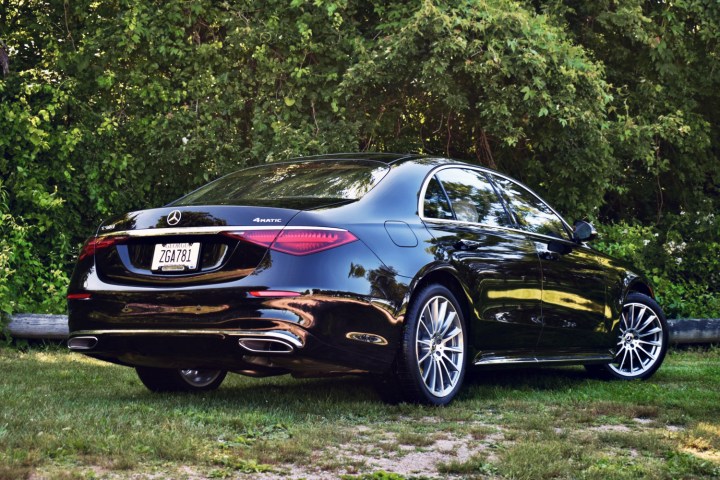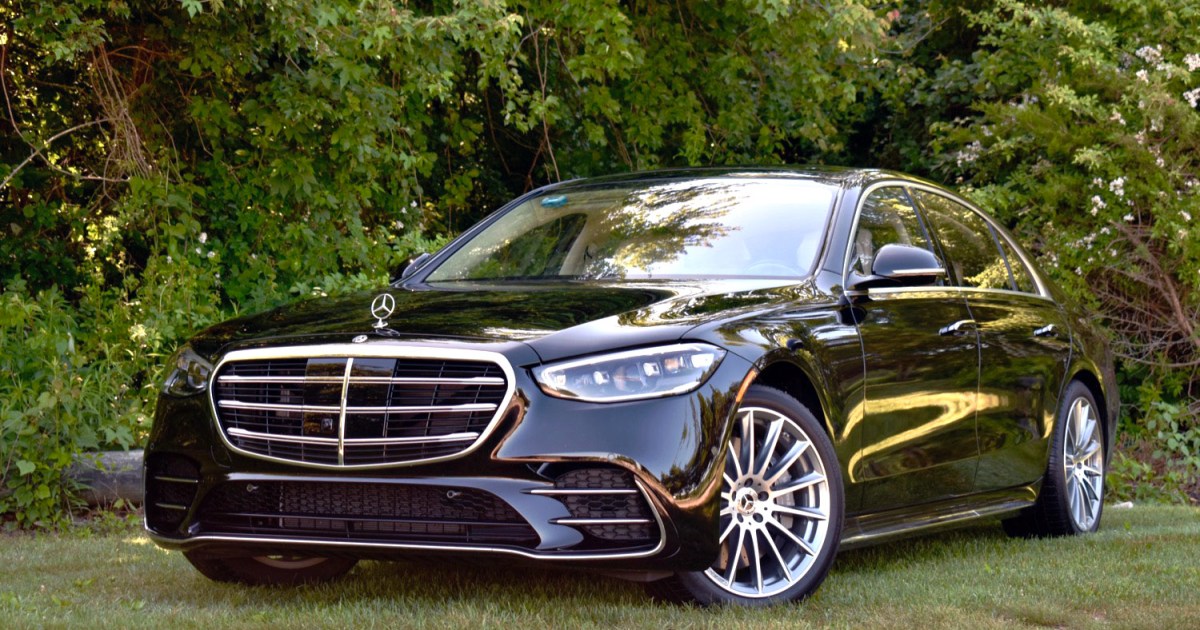
2021 Mercedes-Benz S-Class Approaches Tech Overload
The Mercedes-Benz S-Class is the platonic ideal of a luxury car. Since 1972, it has embodied automotive class and sophistication. It’s also the most important car Mercedes makes.
The S-Class has long served as a technological pioneer for the auto industry, introducing features, such as antilock brakes, airbags, and stability control, that eventually trickled down to more mainstream cars.
Mercedes wants to maintain its reputation as a tech trendsetter, and keep ahead of rivals like the Audi A8, BMW 7 Series, and Lexus LS. With the redesigned 2021 S-Class, Mercedes’ vision of the future includes things like an augmented reality head-up display, facial recognition, and more screens than the bridge of the starship Enterprise.
The 2021 Mercedes-Benz S-Class hits dealerships this summer. Pricing starts at $110,850 for the base S500 4Matic version, and $117,350 for the upper-level S580 4Matic (both prices include a mandatory $1,050 destination charge). We drove the latter, which, when loaded up with a few options, rang up at $128,250 MSRP.
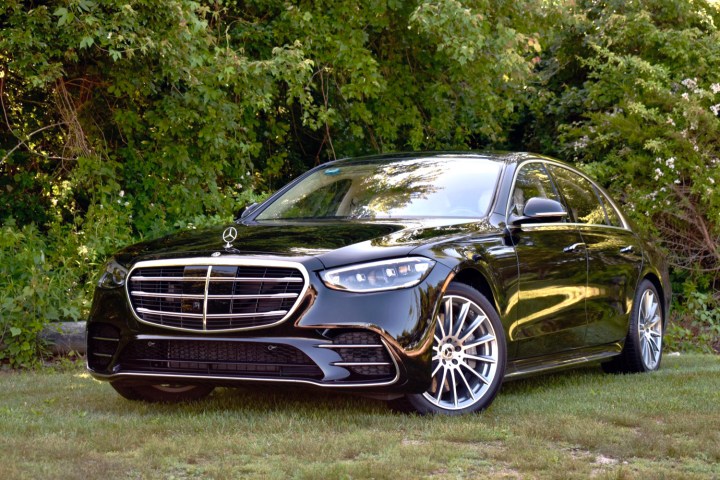 Stephen Edelstein/Digital Trends
Stephen Edelstein/Digital Trends
Design and interior
The exterior styling isn’t a dramatic departure from the previous-generation S-Class. Mercedes seems mostly focused on improving aerodynamics, touting a fairly low drag coefficient of) of 0.22, which is better than a Toyota Prius. You can see the effect of the wind tunnel in the 2021 S-Class’ softer, rounder surfaces, as if the forces of nature gradually smoothed the shape out, like a pebble in a river.
While the exterior is simple and restrained, everything about the S-Class interior is complicated. The front seats have 19 motors for adjustment, plus heating, ventilation, and massage (with 10 modes). They can even automatically adjust to help improve your posture, according to Mercedes. The door handles sit flush with the bodywork for better aerodynamics, and were designed to slide out with a “visually and acoustically attractive movement” when unlocking the doors, per the official Mercedes press release.
Everything about the S-Class interior is complicated.
The S-Class has the most front headroom among its competitive set, but the least front legroom (rear headroom and rear legroom are about average). You’re unlikely to feel claustrophobic in a sedan this big, though, and the Mercedes’ class-leading shoulder room will also give rear-seat passengers lots of personal space. At 12.9 cubic feet, however, cargo space is below average, so pack lightly.
Naturally for a six-figure luxury sedan, you can get Nappa leather upholstery and wood trim. On the S-Class, however, the open-pore wood has bits of aluminum mixed in. Mercedes also sprinkled the cabin with nearly 250 lighting elements, which not only serve an aesthetic purpose (you can choose between 64 ambient-lighting colors), but also connect to the car’s driver-assist and infotainment functions. It’s all a bit overwhelming.
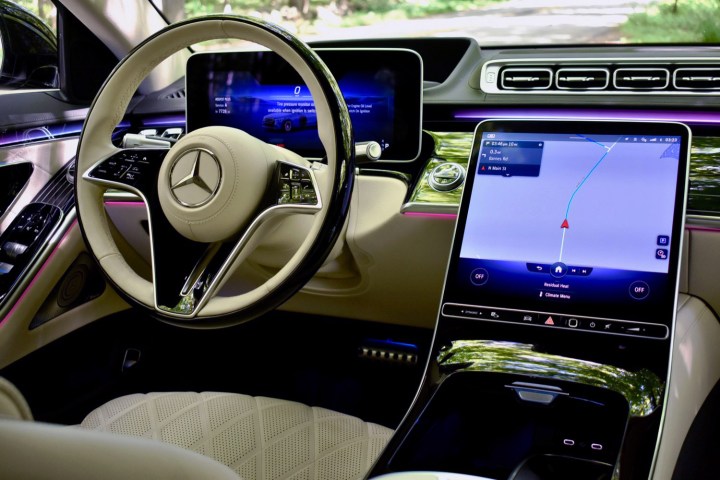 Stephen Edelstein/Digital Trends
Stephen Edelstein/Digital Trends
Tech, infotainment, and driver assist
The S-Class gets a more elaborate version of the Mercedes-Benz User Experience (MBUX) infotainment system previously seen in other Mercedes models. A 12.8-inch OLED touchscreen and 12.3-inch digital instrument cluster are standard, while a pair of 11.6-inch screens and a 7.0-inch tablet for rear-seat passengers, along with a 30-speaker Burmester audio system, can be added at extra cost. Wireless Apple CarPlay/Android Auto, wireless phone charging, and six USB ports (four front, two rear) are standard.
MBUX also includes the “Hey Mercedes” voice assistant previously featured in other Mercedes models, but in the S-Class it works in all seats, an important detail considering many owners will likely be chauffeured. When a person activates the voice assistant, the ambient lighting by their seat flickers, so they know the car is listening.
Mercedes also brought the S-Class closer to the infotainment ideal of a four-wheeled smartphone. Drivers can create custom profiles that automatically switch to preferred settings and can be accessed by voice command, biometric scanner, or even facial recognition. Information can also be sent between the various screens. That’s great if you’re riding in the back, or have a friend sitting there who just found a good restaurant and wants to send directions to the navigation system. It probably won’t be so great if kids get ahold of those rear touchscreens.
Voice control is so reliable that you don’t even need to touch other controls most of the time.
We were impressed by the graphics of both the driver display and 12.8-inch central touchscreen, as well as the voice-control system, which is so reliable you don’t even need to touch other controls most of the time. The layout of the screen was also easy to figure out, and the augmented reality arrows projected on both the screen and head-up display helped us avoid missing turns on unfamiliar roads. However, steering wheel touchpads needed for certain functions seemed a bit too small, and it was hard to figure out which control did what.
Mercedes seems to be putting more emphasis on new infotainment tech than driver-assist tech. The S-Class comes with a long list of driver aids, including a 360-degree camera system, adaptive cruise control, automated lane centering, automatic emergency braking, forward collision warning, blind-spot monitoring, lane-keep assist, traffic sign recognition, and a driver attention monitor. However, none of these features are new; we’ve seen them all before on other cars.
This is still a fairly comprehensive array of driver-assist tech, though, and it works well. On highways, the S-Class smoothly accelerated, braked, and steered its way through curves without driver input. It almost felt like a human driver, albeit a very cautious one.
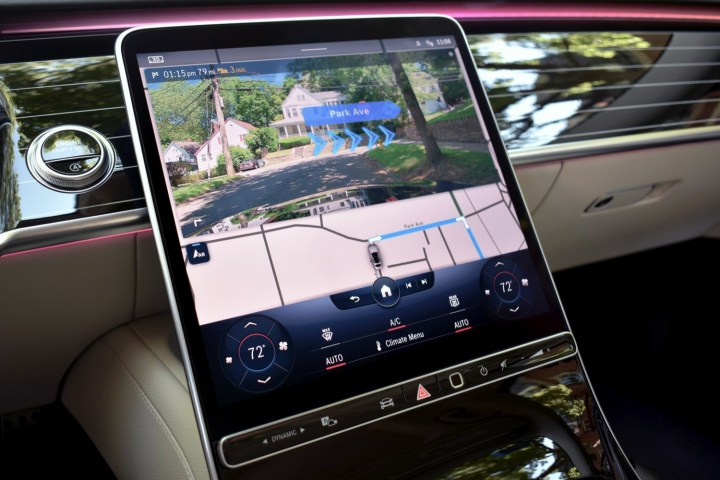 Stephen Edelstein/Digital Trends
Stephen Edelstein/Digital Trends
Driving experience
At launch, the S-Class will be available in two forms, both with a nine-speed automatic transmission, 4Matic all-wheel drive, and EQ Boost mild-hybrid assist.
The base S500 uses a 3.0-liter turbocharged inline-six engine that produces 429 horsepower and 384 pound-feet of torque. The higher-level S580 gets a 4.0-liter twin-turbo V8, good for 496 hp and 516 lb.-ft. In both models, the EQ Boost system can add up to 21 hp and 184 lb.-ft. of torque in short bursts.
Mercedes quotes zero-to-60 mph times of 4.8 seconds for the S500 and 4.4 seconds for the S580 (top speed is electronically limited to 130 mph). Both times are pretty impressive, as they mean these big sedans will be able to out-accelerate some sports cars. However, it’s worth noting that the six-cylinder Lexus LS 500 beats the S500 by 0.2 of a second, while the eight-cylinder BMW 750i xDrive is 0.5 of a second quicker than the S580, according to their makers. A sportier AMG model is likely on the way, but for now, the S-Class can’t claim bragging rights.
You don’t really drive the S-Class, you operate it.
Mercedes also brags that the new rear-wheel steering system makes the gargantuan S-Class as maneuverable as a compact car. At low speeds, it uses an electric motor to turn the rear wheels in the opposite direction of the front wheels, by up to 10 degrees. That indeed makes maneuvering in a parking lot easier, although the car’s physical dimensions will always make this a little nerve-racking.
Its cliché to say that a car handles like it’s on rails, but with the S-Class, it’s also inaccurate. The way this car glides through curves makes the Acela train look clumsy and awkward. And like a train, controlling the V8-powered S580 is mostly about meting out the copious power on tap and hanging on. You don’t really drive it, you operate it.
The S580 is fast but not sporty. It can handle aggressive cornering, but you’re just along for the ride. You’re also isolated from the most visceral aspects of driving. This is a luxury car, after all, so a quiet cabin and cushioned ride are the priorities. Even in the firmer Sport+ mode, the standard air suspension makes pockmarked New York and Connecticut roads feel as smooth as the S-Class’ piano-black interior trim. At highway speeds, the interior was impressively quiet, but with more wind noise than we expected given the S-Class’ aerodynamic shape.
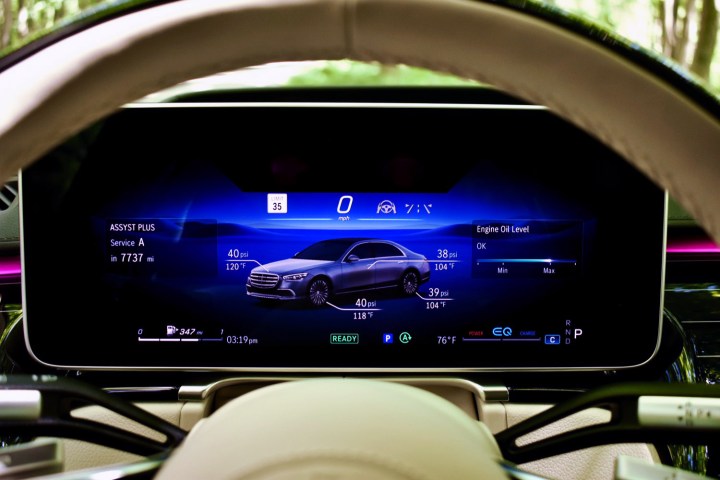 Stephen Edelstein/Digital Trends
Stephen Edelstein/Digital Trends
Gas mileage and safety
Official fuel economy ratings for the 2021 Mercedes-Benz S-Class weren’t available at the time of publication, but we averaged 22.4 mpg over about 300 miles, according to the car’s trip computer. Note that the Lexus LS is available with a hybrid powertrain, offering greater electrification than Mercedes’ EQ Boost mild-hybrid system, while the Audi A8 and BMW 7 Series are available as plug-in hybrids, capable of all-electric driving for limited distances.
Similarly, crash-test ratings from the Insurance Institute for Highway Safety (IIHS) and National Highway Traffic Safety Administration (NHTSA) aren’t available either. Because it’s an expensive, low-volume car, the S-Class probably won’t get safety ratings from either organization.
How DT would configure this car
The ideal S-Class configuration depends on whether you’ll be driving or riding. For drivers, we’d recommend the S580 4Matic with the AMG Line package. That adds rear-wheel steering, the high-end Burmester audio system, augmented reality head-up display, Nappa leather upholstery, and 20-inch or 21-inch wheels.
For those who prefer to have someone else do the driving, we’d swap the AMG Line package for the Executive Line package. This keeps the Nappa leather, rear-wheel steering, Burmester audio system, and head-up display, but adds more creature comforts for rear-seat passengers, including dual 11.6-inch touchscreens and power-adjustable rear seats.
Our take
The 2021 Mercedes-Benz S-Class does everything a six-figure sedan should. It’s fast, comfortable, and decadent. With the twin-turbo V-8 and massaging seats humming away, we could have driven it to the mon and back without complaint.
Several other cars offer a similar experience, though. The Audi A8 and BMW 7 Series have virtually identical resumes to the S-Class, with nicer interior designs. The Bentley Flying Spur and Rolls-Royce Ghost feel more special, but they’re also pricier, and with less-sophisticated tech. The Lexus LS is even further behind in terms of tech, but it’s also a lot easier to live with than the S-Class, and Lexus’ upcoming Teammate driver aid could leapfrog Mercedes.
What about the S-Class’ role as a technological pioneer? While the new S-Class has a staggering list of features, we’re not sure if any of them will be the next big thing in cars. Multiple massage modes are nice, but not exactly relevant to non-plutocrats.
The 2021 S-Class also arrives just as Mercedes prepares to launch its EQS electric car, which also gets a massive 56-inch infotainment display. That seems like a better predictor of the future than the internal-combustion S-Class.
Should you get one?
Yes. The S-Class is no longer a trendsetter, but it’s still a good car.
